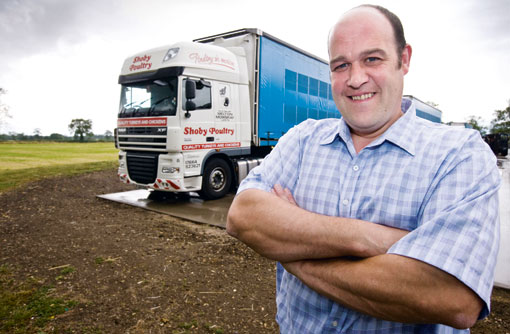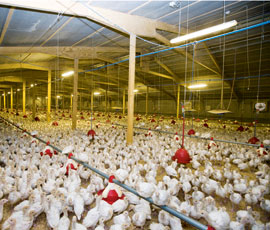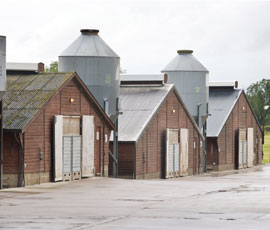Shoby Poultry concentrates on stags

Having a tight focus is the key to success in the turkey business, as Ken Randall discovers.
Success stories in the all-year-round turkey trade are rare these days, but one company, Shoby Poultry based near Melton Mowbray, has gone from strength to strength by concentrating on one thing and doing it well.
 As the UK industry has contracted, this business has made a speciality of supplying nine-week-old growing turkey stags to the major UK players, plus many of the remaining smaller independent all-year-round producers.
As the UK industry has contracted, this business has made a speciality of supplying nine-week-old growing turkey stags to the major UK players, plus many of the remaining smaller independent all-year-round producers.
“In fact, we supply just about everyone left in the all-year-round UK turkey industry these days,” says proprietor James Chandler, who runs the family business with his wife Jill. “We are now the third-largest producer of turkeys in the UK,” he claims, “and no other business in the UK is identical to this.”
The core activity is hatching and brooding turkey stags, and then rearing them on to nine weeks. This is acknowledged to be the trickiest part of the turkey production process. By providing this service to a high standard, Shoby has expanded steadily over recent years, at a time when the UK industry has contracted just as steadily.
The company is now placing around 18,000 day-old stags a week, of which around a quarter are placed on three company-owned sites away from the hatchery, and the rest on contracted independent rearing farms all over the UK. An equal number of females are exported as day-olds.
Mr Chandler puts his success down to exercising control over each stage of the operation and the attention to detail at which a family-run business can excel.
“We do everything, from the egg to the finished grower for sale,” says Mr Chandler. “We have our own catching team, our own lorries, our own poult delivery vehicles.”
It certainly isn’t dependent on using the latest technology: some of the Western incubators in the hatchery are 35 years old, lovingly maintained and still delivering excellent results. “We hatch 38-40,000 poults every week. Most weeks, one flock will achieve over 90% hatchability, and the average we expect for a heavy strain is 82% hatchability, and a medium strain 85-86%.”
All the hatching eggs are sourced through a long-term relationship with a family-run supplier in Brittany.
Long tradition
New methods are constantly evaluated, though, and the hatchery was one of the first in the UK to install a laser machine for beak treatment.
There is a long tradition of poultry farming in the family: “My family has been involved in poultry for 80-odd years. Grandad started with turkeys since they first arrived from the States after the Second World War,” says Mr Chandler.
He was already working full-time for his father, who was also in the turkey business, when he started out renting his own small broiler shed from a woman on a farm nearby as a 17-year-old.
 “I carried on with it, started to build one or two sheds on Dad’s unit, and went from there,” he says.
“I carried on with it, started to build one or two sheds on Dad’s unit, and went from there,” he says.
He switched to producing the nine-week turkeys because at that time, in the late 1980s, there were still a lot of producers needing 500-600 birds each week, all year round, who wanted the job done for them.
“People were struggling with these turkeys, because they’re not the easiest things to brood. So I began by rearing to 10 weeks in those days, and more and more producers were approaching us and asking ‘can you rear to 10 weeks and deliver them?’ These independents have reduced to hardly anything now.”
Then, around 2002-03, the business underwent a dramatic growth.
“It was the result of a problem in the industry, following the banning of Emtryl and certain antibiotics. Turkeys became hard work, and producers had a really difficult time keeping things right. As a result, the business grew overnight.”
At this point Mr Chandler engaged a large number of outside growers, enabling a move to single-age sites in order to improve bio-security.
“We are now in the position where one farm never has more than one week’s difference between the turkeys on it. The key to successful brooding is the small, single-age site. A turkey’s worst enemy is another turkey.
“We now have enormous flexibility, with a host of different size farms, and none are more than 30,000 birds in capacity. A great deal of extra business came from specialising in brooding to an age when the birds are robust enough to go to the wide variety of finishing housing that exists in the UK.”
Logistics
The logistics operation of the business is significant, with two articulated lorries delivering those nine-week stags to almost anywhere in the UK except Scotland.
Each load holds 2,178 birds and there are two loads delivered almost every day, five days a week, amounting to more than 18,000 birds.
“This business needs to be churning out the same number all the time, keeping everything the same. The more turkeys we’ve got, the easier it is to plan and make it work. We now have a constant supply of nine-week-old birds. The only trouble is, there are very few places left to market nine-week turkeys all-year-round.
“It’s important to stick to one strategy, and we haven’t got involved with free range or organic, and we concentrate on providing the most cost-efficient standard bird.”
Mr Chandler maintains that, in 27 years, he has never lost a customer. “We spend a lot of time looking after customers. When we deliver at nine weeks, someone else has to carry on rearing them. We need to get the move right and minimise stress.
“When they come off those lorries, they’re halfway though life. We do everything we can to make sure they’re right when they get there. If there’s any damage, they’re no use whatsoever. That’s why we employ our own catch teams.”
Mr Chandler says the turkey industry has changed “beyond recognition” since he first became involved with it. “Over the past five or 10 years, there is no question that turkey has been in decline, but I’m not certain quite why.
“If you compare it to Europe, we have been left with this terrible imbalance in the use of our turkey. Apart from one day a year, nearly 100% of turkey consumed in the UK is from the stags.
“We’re stuck with all these millions of females looking for other sales. If you go to France or Poland you buy a male turkey, you buy a female turkey and you grow them both for the weekly customer base for meat consumption.
“There’s a lot more that could be done with the UK turkey industry. I’m sure there’s better ways of marketing what we produce.”
One of the biggest weekly users in the UK is the breweries’ carveries, which is all stags, he points out.
“As a result of the imbalance, we’ve developed a good market outside the UK for all the bits we don’t want. There’s a market for surplus female poults, and good markets for dark meat in Germany and elsewhere. It’s balanced itself out like that.
“The export job has been fairly good for a considerable time, but can stop and start overnight, and you can’t get long-term commitment.”
Female poults are sold as far afield as Iran, with major destinations including Greece, Holland, Austria, Germany and Spain.
“We do a lot of that through an agent in the UK because we don’t want to be bogged down with all the detail. All of our export business is ex-hatchery, in customers’ own transport. We just sell the poult and provide the health certificate.”
Broiler production
Broilers still have a role to play at Shoby Poultry, and the largest single site is the homestead and hatchery, where about 1.5m birds are finished a year – a sizeable business in itself.
“It’s easy to get completely involved with turkeys because they cause a lot of work, but I’ve produced broiler chicken since the day I started, with 200,000 here on site,” says Mr Chandler. “That’s what we originally set up Shoby Poultry to do.
“With the hatchery here, for biosecurity reasons we keep it clear of turkeys for 75-80% of year, except for at certain times, especially the summer, when we turn over to turkey growing.”
